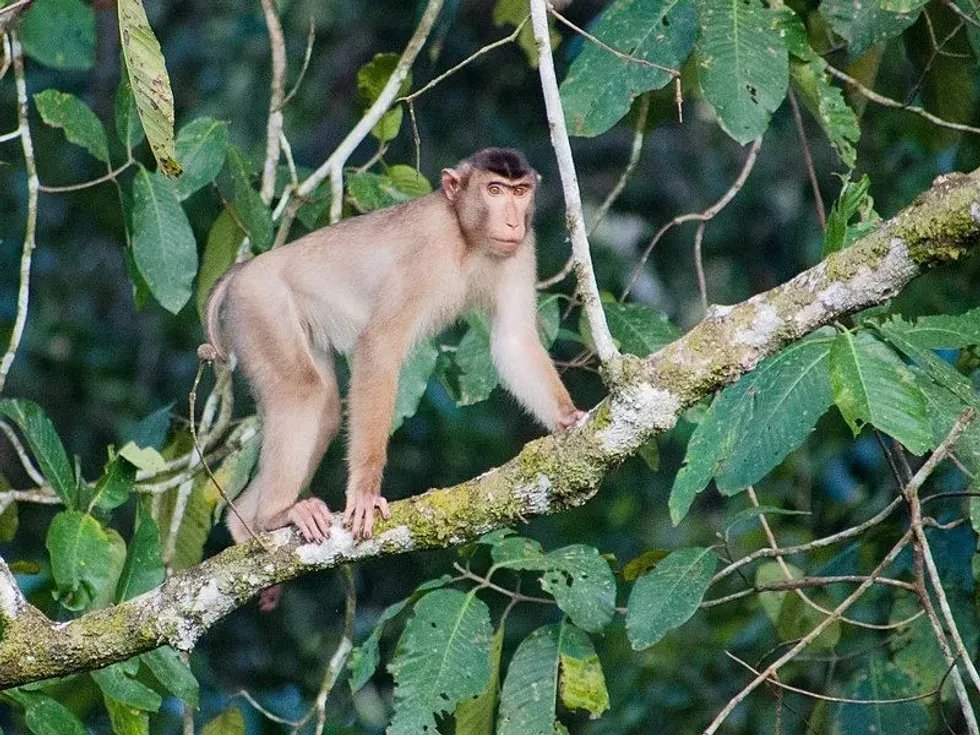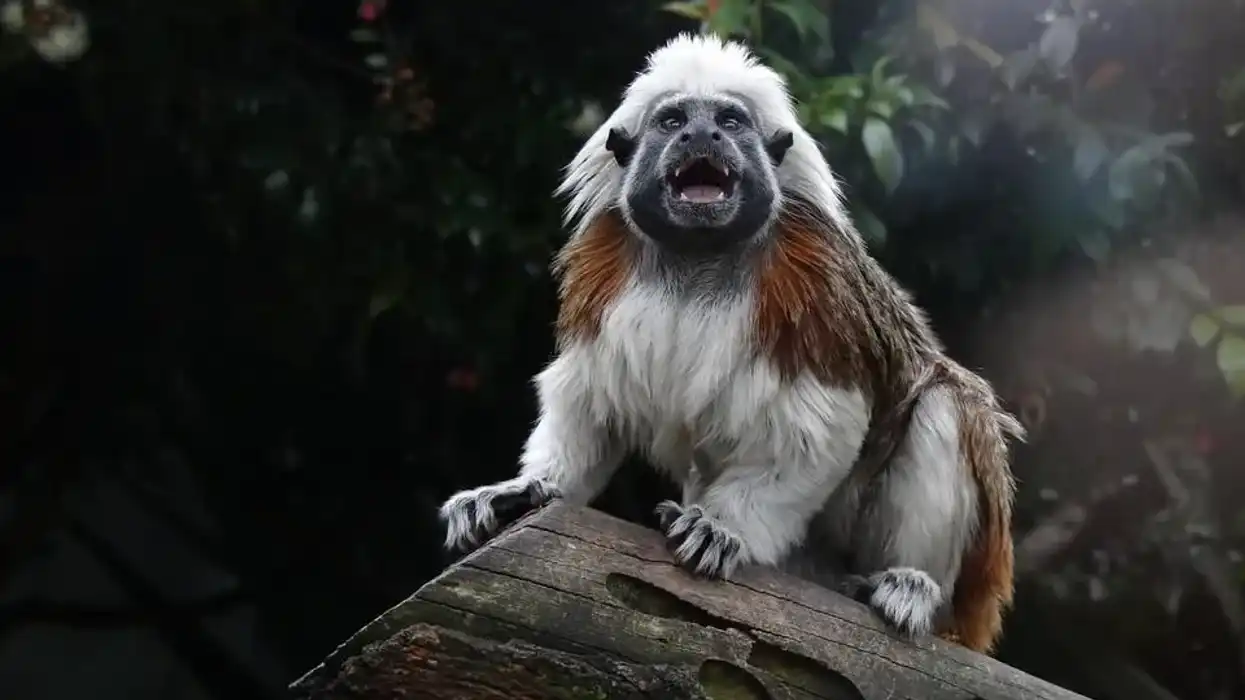The Southern Pig-tailed Macaque (Macaca nemestrina) is a medium-sized macaque endemic to the Southeast Asian countries of Thailand, Indonesia, Malaysia, and Brunei. It goes by other names such as Sunda Pig-tailed Macaque, Sundaland Pig-tailed Macaque, or Sunda.
In local languages, it is also known as 'beruk'. They are known to inhabit tropical rainforests that are dense, as well as plantations.
They are omnivores and they live in groups of 15-40 other macaques. They display sexual dimorphism, with males and females displaying differences in size, tail length, bodily features, and weight. They have ranks - in males, it is based on strength, and in females, based on inheritance.
The conservation status of the Southern Pig-tailed Macaques has recently changed from Vulnerable to Endangered, due to declining populations and habitat loss. Read on to learn more about these monkeys.
For more relatable content, check out these articles on the macaque monkey and Japanese macaque.
Southern Pig-Tailed Macaque Interesting Facts
What type of animal is a southern pig-tailed macaque?
The Southern Pig-Tailed Macaque (Macaca nemestrina) is an old-world monkey.
What class of animal does a southern pig-tailed macaque belong to?
The Southern Pig-tailed macaque (Macaca nemestrina) belongs to the mammal class of animals.
How many southern pig-tailed macaques are there in the world?
There are about 900,000 individual Southern Pig-Tailed Macaques in the world.
Where do southern pig-tailed macaques live?
Southern Pig-tailed Macaques live in the rainforests of Southeast Asia, mainly Thailand, Malaysia, and Indonesia. The southern end of the Malay Peninsula is where Southern Pig-tailed Macaques are found generally.
What is a southern pig-tailed macaque's habitat?
A Southern Pig-tailed Macaque (Macaca nemestrina) lives in the tropical rainforest. They live at sea level up to elevations of 6,200 ft (2000 m).
They also find homes in forests and swamps. Their preferred temperatures are 64-86 degrees Fahrenheit (18-30 degrees Celsius). The rainforests they live in, tend to get more than 8.2 ft (250 cm) of rainfall every year
Who does a southern pig-tailed macaque live with?
The Southern Pig-tailed Macaques (Macaca nemestrina) live with each other in groups of 15-40 individuals. However, groups of up to 81 comprising males and females have been observed. The dominance hierarchy of adult males and females depends on different things.
The male rank is decided by strength and the female rank is decided by lineage and inheritance. The females in the group stay put, but the males can leave the group. Group size may go as high as 80.
For Southern Pig-tailed Macaques, the female leads the group, which also has higher-ranking males. The higher-ranking males also get first preference when it comes to the choice of female mates.
How long does a southern pig-tailed macaque live?
The Southern Pig-tailed Macaque (Macaca nemestrina) lives an average of 26 years in the wild and about 27 years in captivity.
How do they reproduce?
The Southern Pig-tailed Macaques reproduce by mating. The Southern Pig-tailed Macaque is an old-world, medium-sized species that breed all year round.
Females attain sexual maturity by the time they're three years old and males achieve it when they're four or five. Adult females in the group are known to have multiple sexual partners. They have ranks when it comes to copulation, and it is known that females have more than a few partners.
The gestation period lasts for almost six months, or 172 days, after which the adult females give birth. The female continues to nurse the infant for around four to five months.
What is their conservation status?
The conservation status of the Southern Pig-Tailed Macaques is Endangered as per the International Union for Conservation of Nature. Habitat loss has changed the Conservation Status of the Southern Pig-tailed Macaque to Endangered, which was previously Vulnerable.
Southern Pig-Tailed Macaque Fun Facts
What does a southern pig-tailed macaque look like?
Southern Pig-tailed Macaques have bodies that are buff-brown. Their backs and crowns are a darker shade. Around the corner of their eyes is a red streak, and their eyes are light amber-colored.
Females do not have mane-like hair around their faces that males have. The canine teeth of the male are twice as big as the female's. They get their names from their tails being like a pig's, almost hairless, short, and half-erect.
A child, when born, has a black coat, which begins changing to adult colors after three months. Also, males have bigger bodies than females.
Males are 20–23 in (50–58 cm) long, while the females are 15–19 in (38–48 cm) long. The tails of the Southern Pig-tailed Macaques also vary according to sex. Males have tails ranging from lengths 63-97 in (160-245 mm), and females have tails that are 51-100 in (130-253 mm) long.

How cute are they?
Southern Pig-tailed Macaques are very cute animals. Their human-like emotive faces, 'coo' vocalizations, visual cues, body language, puckering, kissing, and peculiar mating rituals, make them a very delightful species of animals.
How do they communicate?
They communicate via vocalizations, visual cues, body language, puckering their lips, and facial expressions. Their vocal sounds include coos, barks, squeals, and growls. They are usually silent but use these forms of communication in a variety of situations.
How big is a southern pig-tailed macaque?
A Southern Pig-tailed Macaque's length ranges from 18.4-22.2 in (46.7-56.4 cm), which makes it three to five times bigger than the Pygmy marmoset.
How fast can a southern pig-tailed macaque jump?
Since they are from the monkey family, Southern Pig-tailed Macaques may be able to jump from tree to tree with speeds of up to 35 mph (56 kph).
How much does a southern pig-tailed macaque weigh?
A Southern Pig-Tailed Macaque may weigh anywhere between 11-33 lb (5-15 kg).
What are the male and female names of the species?
There are no specific names for the male and females of the Southern Pigtailed Macaque family.
What would you call a baby southern pig-tailed macaque?
A baby Southern Pig-tailed Macaque may be called an infant.
What do they eat?
Southern Pig-tailed Macaques are largely frugivorous, but they are omnivorous creatures. They eat fruits, berries, seeds, cereals, invertebrates, and fungi.
How active are they?
Southern Pig-tailed macaques are active creatures, living more on the ground rather than in trees. They forage on the trees and flee on the ground. They like to swim and they are on the move most of the time (61% of their time on the ground).
Would they make a good pet?
They would not make good personal pets, but they are known to be kept in zoos. They have certain aggression to their nature which would not make them a good pet.
Did you know...
After an infant male comes of age, he leaves to join a new group. The female inherits her mother's rank in the social groups. Large groups tend to break into smaller social groups when foraging. The male-to-female gender ratio is typically between 1:3 to 1:8.
A peculiar behavior among these macaques is that adult females are likely to kidnap month-old offspring of other females when they start exploring their surroundings. Other risks that a month-old may face exploring are dehydration and starving if it remains away from its mother for too long.
How many types of macaques are there?
There are 23 different species of macaques in total. The Rhesus Macaques, Barbary Macaques, Southern Pig-tailed Macaques, Japanese Macaques, Assam Macaques, and Arunachal Macaques are some of the commonly known species of Macaques.
Are macaques endangered?
Several species of Macaques are endangered. According to the IUCN, the following species are classified as Endangered - Arunachal macaque, Barbary macaque, Lion-tailed macaque, Moor macaque, Southern pig-tailed macaque, and Toque macaque
The following species are classified as Vulnerable - Bonnet macaque, Booted macaque, Gorontalo macaque, Heck's macaque, Northern pig-tailed macaque, Stump-tailed macaque, and Tonkean macaque
Near Threatened macaques include the Assam macaque, and Tibetan macaque
Finally, the Critically Endangered macaques are the Celebes crested macaque, Crab-eating macaque, and Pagai Island macaque.
Here at Kidadl, we have carefully created lots of interesting family-friendly animal facts for everyone to discover! Learn more about some other mammals from our red fox surprising facts or okapi fun facts.
You can even occupy yourself at home by coloring in one of our free printable southern pig-tailed macaque coloring pages.










